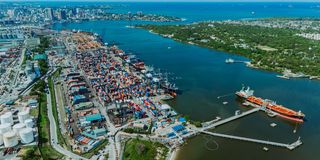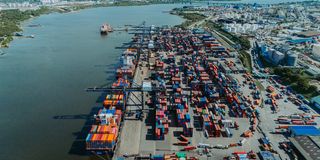Milestone reform set to unlock manufacturing growth, streamline exports, and elevate trade visibility across the nation

An aerial view of the Dar es Salaam port.
What you need to know:
- This operational reform is being hailed as a transformational step in the modernization of Tanzania’s maritime logistics sector, with far-reaching benefits for manufacturers, exporters, and regional trade corridors.
The Dar es Salaam port poised to enhance efficiency as it launches Fixed Berthing Windows (FBW) for Terminal 2
In a landmark shift poised to redefine the future of port operations in Tanzania, Tanzania East Africa Gateway Terminal Limited (TEAGTL) the private operator of Terminal 2 has successfully implemented the Fixed Berthing Windows (FBW) concept at the Dar es Salaam Port.
This operational reform is being hailed as a transformational step in the modernization of Tanzania’s maritime logistics sector, with far-reaching benefits for manufacturers, exporters, and regional trade corridors.
Infusing structure and predictability of shipments through Dar es Salaam port
FBW introduces a structured system of pre-assigned berthing slots, replacing the traditional first-come-first-served arrangement.
Considered as an industry best practice, the concept of Fixed Berthing Window (FBW) aims to reduce waiting time for vessels and accelerate cargo movement through the port of Dar es Salam.
The result is enhanced predictability, reduced vessel waiting times, and improved coordination between shipping lines, logistics providers, and cargo owners.
With the first-come-first-served arrangement for handling vessels being riddled with inefficiencies and causing congestion and a long queue of vessels waiting outside the port, TEAGTL was keenly cognizant of the need to improve this aspect of the port’s performance.
Given the interconnected nature of global transport networks, delays at preceding ports can be magnified at latter ports of call, hampering supply chain integrity and deterring global container carriers from calling at the port - making the shift to FBW an imperative for delivering superior service to Carriers and Tanzanian export and import (EXIM) community.
In the last three months alone, out of 65 vessels handled by TEAGTL at Terminal 2, out of which more than 32% were served under Fixed Berthing Windows, with the proportion progressively increasing each month, to reach 48% in March - a remarkable achievement in such a short span. The terminal now aims to scale this up to 75% FBW coverage by the end of May, indicative of strong adoption by major shipping lines and growing confidence in the system.
“The introduction of the FBW concept marks a significant milestone in enhancing efficiency, and service delivery in our maritime ports sector, strengthening our competitiveness as a regional trade hub. It is a testament to TPA’s unwavering commitment in partnering with TEAGTL as a private entity in view of developing a world-class port ecosystem at the Dar es Salaam Port that accelerates Tanzania’s trade and economic growth to support our broader vision of national development.”
Mr. Plasduce Mbossa, Director General, Tanzania Ports Authority
“The implementation of FBW at the TEAGTL terminal is a notable stride towards efficiency, transparency, and predictability. This initiative directly supports TASAC’s mandate to regulate and promote safe, secure, and environmentally sound shipping practices, enhancing Tanzania’s competitiveness in global trade. This progress is vital to our vision of fostering a resilient, well-regulated maritime industry.
Mr. Mohamed Salum, Director General, Tanzania Shipping Agencies Corporation (TASAC)
“In line with our emphasis on addressing the longstanding challenge of unpredictable waiting times for vessels, we leveraged our collective experience from operating 10 container terminals in India, including Mundra – which is India’s largest container port – comprising aggregate volume of 11 million TEUs, bringing a vast repository of Sectoral knowledge and expertise. I am proud that our Operations and Commercial teams rose to the challenge and ensured successful implementation of FBW.”
This is not just a terminal improvement - it’s a shift in the way trade is facilitated at the national level. Our efforts are aimed at the Tanzanian manufacturing and perishables sectors—to build a competitive advantage through supply chain visibility for exporters and importers, reduce inventory levels, and make Tanzanian products more competitive in global markets. Ultimately, our goal is to create the confidence and efficiency needed for shipping lines to build more tonnage into and out of Tanzania.”

An aerial view of the Dar es Salaam port.
Mr. Shahzad Athar, Director, Tanzania East Africa Gateway Terminal Limited
“The success of the FBW concept is a remarkable testimonial to the dedication and efforts of our entire team. By providing fixed and predictable berthing schedules, FBW is already helping to reduce vessel waiting times and improve overall port performance.
To complement this, we are also expanding our reefer plug capacity to meet the growing demand for cold-chain logistics. This is particularly important for high-value agricultural exports like avocadoes, where reliability and freshness are critical.
Together, FBW and enhanced reefer infrastructure will support Tanzanian exporters to expand in global markets.”
Capt. Jeyaraj Thamburaj, CEO, Tanzania East Africa Gateway Terminal Limited
A Game-Changer for Tanzania’s local producers and exporter to foreign markets
The manufacturing and industrial sectors are among the biggest beneficiaries of this reform. With FBW in place, importers, exporters can better synchronize production with vessel schedules, improve delivery timelines, and reduce importation and exploration costs associated with inventory, storage, and demurrage. The result is stronger export competitiveness and more efficient integration into global value chains.
This will also help unlock the latent potential in perishables and agro-exports, where timing is critical, while simultaneously catalyse growth in ancillary sectors such as cold chain logistics, warehousing, and distribution.
Upcoming initiatives to enhance cargo visibility at the Terminal 2
TEAGTL is planning to introduce several critical initiatives at the Terminal 2 of the Dar es Salaam Port aimed at further enhancing trade visibility, transparency, and customer service—solidifying Dar es Salaam Port’s position as a reliable and modern logistics hub in East Africa. These include:
Real-Time container tracking: TEAGTL will launch a digital tracking system that enables shippers to monitor the status and movement of containers throughout the terminal in real time. This will significantly improve planning, reduce uncertainty, and strengthen end-to-end supply chain visibility.
Digital documentation platform: A streamlined, paperless system for processing cargo documentation will go live - minimizing manual interventions, reducing delays, and improving compliance accuracy for both imports and exports. The platform will also allow trade participants to seamlessly interact with port operators, shipping lines, and other key stakeholders, while enabling secure digital payments across multiple parties in the logistics chain.
24/7 customer support: operationalization of a dedicated customer support ecosystem, including a round-the-clock hotline and WhatsApp channel, to provide instant assistance, status updates, and resolution of queries for cargo owners, freight agents, and transporters.
These upcoming initiatives are not just technological upgrades—they are strategic investments in building a smarter, faster, and more responsive trade environment for Tanzania.
National and regional impact
With increasing trade volumes and growing demand for efficiency, the reforms at Dar es Salaam Port are being seen as a national milestone in Tanzania’s logistics modernization. The changes also enhance the port’s capacity to serve neighboring landlocked countries such as Uganda, the Democratic Republic of Congo (DRC), Burundi, Rwanda, Zambia, and Malawi, further solidifying Tanzania’s position as a regional gateway for trade and transit.
By combining operational excellence with digital innovation and regulatory alignment, TEAGTL is setting a new benchmark for how African ports can modernize while directly supporting national economic goals, industrialization, and private sector growth.


